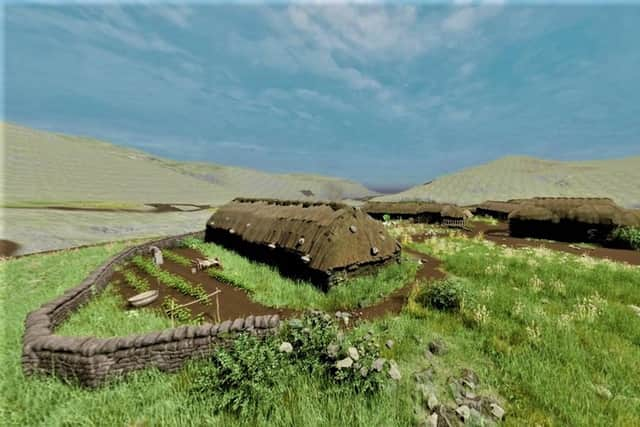Tour a lost Highland settlement destroyed during Clearances
Now a settlement destroyed during the Highland Clearances has been brought back to life in an impressive digital visualisation that takes viewers to the heart of the township of Caen for a glimpse of everyday life before it vanished in the early 19th Century.
Caen sits in the strath of Kildonan around a mile from Helmsdale. These lands were farmed for more than 6,000 years but radical changes led by the Marquess of Stafford, later the Duke of Sutherland, stripped the strath of the majority of its people between 1813 and 1819.


Advertisement
Hide AdAdvertisement
Hide AdSuch was the force of the Clearances here that they provoked one of the first recorded protests against the evictions anywhere in the Highlands.
Today, the crumbling footings of the old buildings at Caen, where 100 people lived in the early 1900s, give a hint of what once could be found here with the digital re imagining of the township now unlocking the vanished way of life on the banks of the River Helmsdale.
Jacquie Aitken, digital heritage officer at Timespan museum in Helmsdale, said: “ The reconstruction of the township of Caen gives us an authentic insight into daily life of a farming community in Kildonan before the Highland Clearances.
“When you go up there today you can see the old footings of the buildings. You get the sense of the community there. It is pretty quiet there today, but it was not always that way.”
The reconstruction of Caen has been carried out in a collaboration between Timespan and Sarah Kennedy of the Open Virtual Worlds project at St Andrews University and builds on the findings of an excavation carried out in 2013 by archaeologist Dr Keir Strickland, then with the University of Highlands and Highlands.
A 30ft longhouse that was recorded by Dr Strickland features in the visualisation, as does a whisky still, the remains of which were also found.
The style of longhouse once found at Caen is thought to have been inspired by building techniques used by the Vikings, who arrived in Sutherland in the 9th Century. A shortage of wood in the area inspired the narrow property that also had to be strong enough to support a heavy thatched roof.
Caen, which means ‘enclosed cultivated area’ in Gaelic, appears in records as far back as 1360.
Advertisement
Hide AdAdvertisement
Hide AdIt was documented by Donald Sage, the minister’s son at Kildonan, who described Caen as a “snug and sheltered spot” where around 100 people lived.
Change came hard in Kildonan after the Staffords hired their first commissioner, William Young, in 1809 to press ahead wih the radical overhaul of the estate with Patrick Sellar then hired as factor.
By 1813, farmers from the Borders were invited to Sutherland to lease land for sheep rearing.
According to accounts, one of the farmers claimed that he was confronted and attacked by a group of tenants in Kildonan and “barely escaped with his life”. A temporary courtroom was set up to deal with the allegations with more than 300 people arriving at the pub to witness proceedings.
As tensions built, estate staff were made special constables with military force sent from Fort George.
Within three months large areas of upper Kildonan had been entirely cleared with some tenants offered small strips of poor land close to the cliffs at Helmsdale.
Many took emigration as a way out. In June 1813, 94 people from the strath left on a troubled passage to Canada, where they spent a cruel winter at Hudson’s Bay before an 800-mile journey to Red River. Their new home, called Kildonan, is now a suburb of Winnipeg city.
In the 1970s, there was serious discussion about repopulating Kildonan with the move recommended by the Highlands Development Board. However land ownership issues and the impending oil boom meant the vision never materialised.
Advertisement
Hide AdAdvertisement
Hide Ad-This work was funded by the EU Northern Peripheries and Arctic Program (ERDF) as part of the Connected Culture and Natural Heritage in a Northern Environment (CINE) For more information go to: https://www.facebook.com/OpenVirtualWorlds/
A message from the Editor:Thank you for reading this story on our website. While I have your attention, I also have an important request to make of you.With the coronavirus lockdown having a major impact on many of our advertisers - and consequently the revenue we receive - we are more reliant than ever on you taking out a digital subscription.
Subscribe to scotsman.com and enjoy unlimited access to Scottish news and information online and on our app. With a digital subscription, you can read more than 5 articles, see fewer ads, enjoy faster load times, and get access to exclusive newsletters and content. Visit https://www.scotsman.com/subscriptions now to sign up.
Our journalism costs money and we rely on advertising, print and digital revenues to help to support them. By supporting us, we are able to support you in providing trusted, fact-checked content for this website.
Joy Yates
Editorial Director